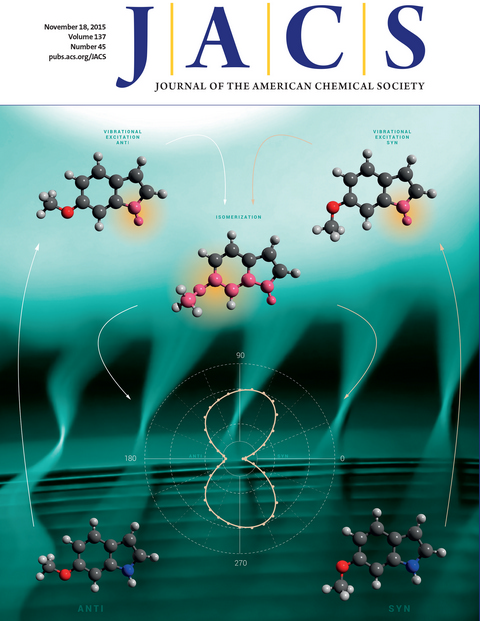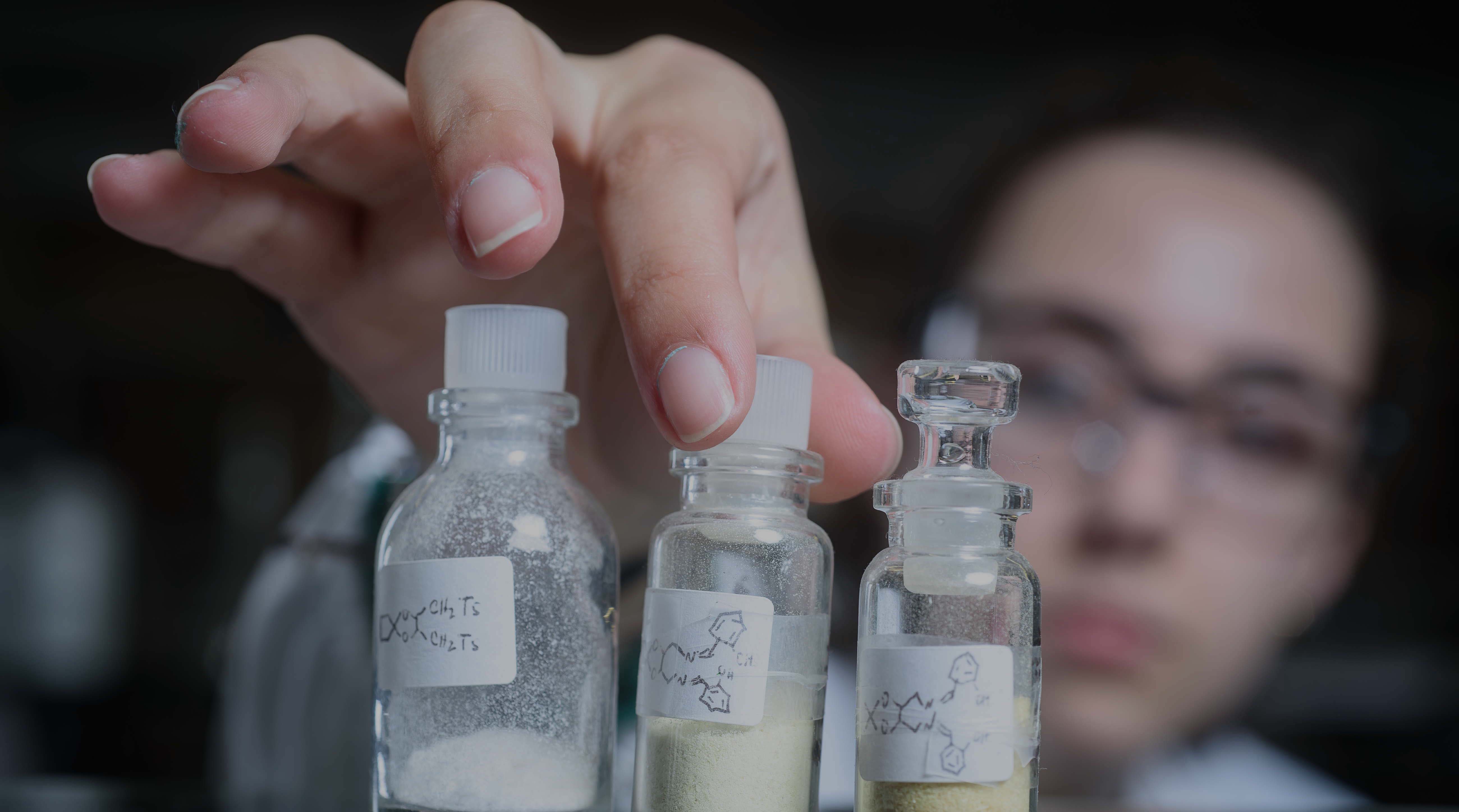Quantum tunneling chemistry
We have been investigating quantum tunneling chemistry, specially in nitrene reactive intermediates (open‑shell R‒N species) and their slippery potential energy surface using a combination of a cryogenic matrix environment and a tunable narrowband radiation source to selectively produce and induce photochemistry of the different species resulting from suitable initial azide precursors. In this way, we have unraveled new gateways to nitrenes, characterized new challenging species and discovered fascinating cases of tunneling reactions. Direct spectroscopic observations of the first tunneling reactions in nitrene chemistry, as well as intramolecular hydrogen-abstraction tunneling, heavy-atom tunneling including through crossing triplet and singlet surfaces, competitive tunneling reactions, and the demostration of an innovative strategy to switch ON hydrogen-abstraction tunneling reactions by precise external IR radiation, have put our research group in the forefront of this research filed. We are now developing new instrumentation and advanced computational tools to carry out groundbreaking investigations in solution conditions. We envision, for instance, that including tunneling reactivity in the catalysts design can lead to tremendous improvements in catalytic reactions and bring new discoveries to the field.
Selected Recent References:
1. “Hydrogen Tunneling Exhibiting Unexpectedly Small Primary Kinetic Isotope Effects”, J. P. L. Roque, C. M. Nunes, P. R. Schreiner and R. Fausto, Chem. Eur. J., 30 (2024) e202401323.
2. “Simultaneous Tunneling Control in Conformer-Specific Reactions“ C. M. Nunes, J. P. L. Roque, S. Doddipatla, S. A. Wood, R. J. McMahon, and Rui Fausto, J. Am. Chem. Soc. 144 (2022) 20866.
3. “Switching on H-tunneling Through Conformation Control”, J. P. L. Roque, C. M. Nunes, L. P. Viegas, N. A. M. Pereira, T. M. D. V. Pinho e Melo, P. R. Schreiner and R. Fausto, J. Am. Chem. Soc., 143 (2021) 8266.
4. “Heavy-Atom Tunneling Through Crossing Potential Energy Surfaces: Cyclization of a Triplet 2-Formylarylnitrene to a Singlet 2,1-Benzisoxazole”, C. M. Nunes, L. P. Viegas, S. A. Wood, J. P. L. Roque, R. J. McMahon and R. Fausto, Angew. Chem. Int. Ed., 59 (2020) 17622.
5. “Competitive Nitrogen versus Carbon Tunnelling”, C. M. Nunes, A. K. Eckhardt, I. Reva, R. Fausto and P. R. Schreiner, J. Am. Chem. Soc. 141 (2019) 14340.
6. “Evidence of a Nitrene Tunneling Reaction: Spontaneous Rearrangement of 2-Carboxyaldehyde Phenylnitrene to Imino Ketene in Low-Temperature Matrices”, C. M. Nunes, S. N. Knezz, I. Reva, R. Fausto and R. J. McMahon, J. Am. Chem. Soc., 138 (2016) 15287.
Vibrational excitation chemistry
 We has been pioneer in using tunable IR laser light to get exceptional control over molecular conformations and to generate elusive conformers, otherwise inaccessible to experimentation. These transformations are explored in low-temperature matrix isolation, which provides ideal conditions for investigating chemical processes with low energy barriers, suitable to be activated by IR light. Typically, energy is deposited first stretching overtones that have substantial energy alongside a sufficiently significant absorption cross section. This way, it has been shown that vibrational excitation can induce rotamerization of a light H atom (e.g., of an OH or SH group) or heavy fragments (e.g., aldehyde, hydroxymethyl, and methoxy), even when they are located remotely in relation to the excited vibrational mode. In a recent major breakthrough, we have demonstrated that bond-breaking/bond-forming reactions can also be induced by IR vibrational excitation under matrix-isolation conditions. Further on, we have developed the concept of remote vibrational antenna to demonstrate a conceivable generalized strategy for inducing bond-breaking/bond-forming reactions with exceptional precision.The potentialities of IR vibrational excitation can surpass conventional catalytic, thermal, and electronic excitation approaches, and one can envision this methodology applied to mimic the controlled activation of drugs or switch of optoelectronic devices.
We has been pioneer in using tunable IR laser light to get exceptional control over molecular conformations and to generate elusive conformers, otherwise inaccessible to experimentation. These transformations are explored in low-temperature matrix isolation, which provides ideal conditions for investigating chemical processes with low energy barriers, suitable to be activated by IR light. Typically, energy is deposited first stretching overtones that have substantial energy alongside a sufficiently significant absorption cross section. This way, it has been shown that vibrational excitation can induce rotamerization of a light H atom (e.g., of an OH or SH group) or heavy fragments (e.g., aldehyde, hydroxymethyl, and methoxy), even when they are located remotely in relation to the excited vibrational mode. In a recent major breakthrough, we have demonstrated that bond-breaking/bond-forming reactions can also be induced by IR vibrational excitation under matrix-isolation conditions. Further on, we have developed the concept of remote vibrational antenna to demonstrate a conceivable generalized strategy for inducing bond-breaking/bond-forming reactions with exceptional precision.The potentialities of IR vibrational excitation can surpass conventional catalytic, thermal, and electronic excitation approaches, and one can envision this methodology applied to mimic the controlled activation of drugs or switch of optoelectronic devices.
Selected Recent References:
1. “Differential Tunneling-Driven and Vibrationally-Induced Reactivity in Isomeric Benzazirines”, J. P. L. Roque, C. M. Nunes, P. R. Schreiner and R. Fausto, Chem. Eur. J., 28 (2022) e20220230
2. “Inducing Bond-Breaking/Bond-Forming Reactions by Infrared Vibrational Excitation of a Remote Antenna”, C. M. Nunes, N. A. M. Pereira, L. P. Viegas, T. M. V. D. Pinho e Melo and R. Fausto, Chem. Comm. 57 (2021) 9570.
3. “Bond-Breaking/Bond-Forming Reactions by Vibrational Excitation: Infrared-Induced Bidirectional Tautomerization of Matrix-Isolated Thiotropolone”, C. M. Nunes, N. A. M. Pereira, I. Reva, P. S. M. Amado, M. L. S. Cristiano and R. Fausto, J. Phys. Chem. Lett., 11 (2020) 8034.
4. “Conformational Isomerization Triggered by Vibrational Excitation of a Second Stretching Overtones”, C. M. Nunes, I. Reva and R. Fausto, Phys. Chem. Chem. Phys., 21 (2019) 24993.
5. “Conformational Control Over an Aldehyde Fragment by Selective Vibrational Excitation of Interchangeable Remote Antennas”, A. J. S. Lopes, C. M. Nunes, I. Reva and R. Fausto, Chem. Comm. 54 (2018) 4778.
6. “Conformational Switching by Vibrational Excitation of a Remote NH Bond”, A. J. Lopes Jesus, I. Reva and R. Fausto, J. Am. Chem.Soc., 137 (2015) 14240.
Mechanistic insights, characterization of reactive intermediates and unusual molecules.
We have successfully demonstrated the generation and stabilization in cryogenic matrices of reactive and unusual species such as radicals, carbenes, nitrenes, 1,3-dipolar species, antiaromatic systems, and many other typically short-lived reactive intermediates. This has allowed us to carry out unique investigations to probe their detailed structural, spectroscopic, and photochemical characterization and investigate their reactivity. For example, we shed light on the generation and photochemistry of the phenoxy radical and its sulfur analogue, and uncovered a pioneering case of bond-shift isomers in 1,3-dipolar species, specifically phenylnitrile imines existing in allenic and propargylic forms. In conjunction with quantum chemical computations, we have also been providing important contributions to the field of reaction mechanisms. We envision our future work in this area supporting the development of new materials, organic reactions and organocatalysts.
Selected Recent References:
1. “On the Carbenic Nature of Nitrile Ylides: Experimental and Computational Characterization of Hydroxy and Amino Nitrile Ylides”, Cl. M. Nunes, A. J. Lopes Jesus, M. T. S. Rosado, and R. Fausto, Eur. J. Org. Chem. 2023, e202301103.
2. “Photochromism of a Spiropyran in Low‑Temperature Matrices: Unprecedented Bidirectional Switching between a Merocyanine and an Allene Intermediate”, C. M. Nunes, N. A. M. Pereira, and R. Fausto, J. Phys. Chem. A 2022, 126, 2222.
3. “UV-Induced Photochemistry of 1,3-Benzoxazole, 2‑Isocyanophenol, and 2‑Cyanophenol Isolated in Low-Temperature Ar Matrixes”, I. Reva, A. J. Lopes Jesus, C. M. Nunes, J. P. L. Roque, and R. Fausto, J. Org. Chem. 2021, 86, 6126.
4. “Photoinduced Reactivity in a Dispiro-1, 2, 4-trioxolane: Adamantane Ring Expansion and First Direct Observation of the Long-Lived Triplet Diradical Intermediates”, E. M. Brás, L. I. L. Cabral, P. S. M. Amado, M. Abe, R. Fausto, and M. L. S. Cristiano, J. Phys. Chem. A 2020, 124, 4202.
5. “Photogeneration of the Thione Forms of Thiophenol”, I. Reva, M. J. Nowak, L. Lapinski and R. Fausto, Phys. Chem. Chem. Phys, 17 (2015) 4775.
6. “Bond-Shift Isomers: The Co-existence of Allenic and Propargylic Phenylnitrile Imines” C. M. Nunes, I. Reva, R. Fausto, D. Bégué, and C. Wentrup, Chem. Commun. 2015, 51, 14712.
7. “Generation and Characterization of a 4p-Electron Three-Membered Ring 1H‑Diazirine: An Elusive Intermediate in Nitrile Imine− Carbodiimide Isomerization” C. M. Nunes, C. Araujo-Andrade, R. Fausto, and I. Reva, J. Org. Chem. 2014, 79, 3641.
Production of small aggregates and energetic crystals made by rare conformers.
Preparation and characterization of high-energy conformers, dimers and complexes of these species has been achieved by controled conformational changes induced by narrow band selective excitation of low-energy common conformers isolated in cryogenic matrices, followed by thermal mobilization under temperature controled conditions. Procedures were developed for subsequent preparation of high-energy crystals based on these high-energy rare conformers --- under construction ---
